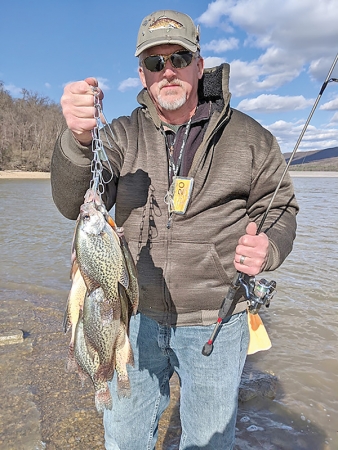Spring is here, at least I think it is, you wouldn’t know it was spring based on the weather since that white stuff keeps showing up. Of course, with spring comes trout fishing and spring gobbler hunting, but it’s also one of the best times to pursue some great panfishing and, more specifically, crappie fishing. As a young man, when I first got into fishing, it was all about trout and bass; chasing after panfish was for little kids — or so I thought. Over the years, I gradually came to realize how rewarding chasing after panfish could be. In those early years, my panfishing was mostly for bluegills, but when I discovered how much fun crappie fishing could be, I quickly added them to my list of often targeted species of fish. Not only are they fun to catch, but they are also at the top of the list for fine table fare.
We actually have two species of crappies inhabiting many of our lakes here in Pennsylvania — the black crappie and white crappie. To be honest, I doubt most people, unless they are dedicated panfish enthusiasts, can tell the difference between the two species. I often catch both species on the same lake, in the same location, using the same techniques and at the same time. Don’t let the terms black and white fool you; there’s not that much difference in color between the two. The black crappie is usually a bit darker than the white crappie, but that can vary a great deal depending on a number of factors, including water clarity.
There are some other identifying characteristics to look for to help you distinguish between the two. One thing to look for is the arrangement of the black markings on the sides of the fish; on the black crappie, the black markings are scattered randomly with no pattern along each side. On the white crappie, the black markings are a series of five to ten vertical bands. On a white crappie, the distance from the eye to the front of the dorsal fin is greater than the length of the dorsal fin base; that distance is equal on a black crappie. Finally, the white crappie will usually have six spines on the dorsal fin while the black crappie will have seven or eight.
As I mentioned earlier, knowing the difference between the two species probably won’t make a bit of difference when it comes to catching them; the same lures, baits, and techniques work for both.
Any kind of topwater lure is a poor choice since crappies seldom feed on the surface. I have taken a few rare ones while fishing a surface popper for bluegills, but that is a definite exception.
In spring, crappies begin to move from the deeper portion of a lake into shallower water to spawn. They particularly favor woody structure or rock structure in depths of a few feet to around ten feet. As water temperatures increase as we move into summer, crappies will move back to deeper areas of the lake and suspend at various depths in schools.
While crappies can literally be caught year-round (they are a top target of ice-fishermen) spring is a good time to go after them but don’t think that once they have moved to deeper water, they are uncatchable. Changing techniques and especially depths can keep you catching crappies all year long.
Check all regulations for keeping crappies on the lakes you fish since special regulations are in place on a number of lakes. While I like to keep some for the dinner table, I also like to limit my take to ensure that there will be plenty of crappies down the road.





Leave a Comment
Your email address will not be published. Required fields are marked with *